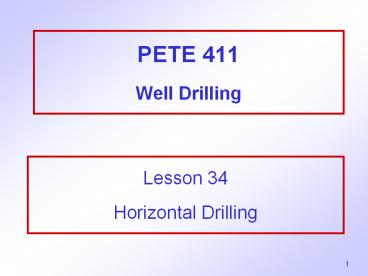PETE 411 Well Drilling - PowerPoint PPT Presentation
1 / 36
Title:
PETE 411 Well Drilling
Description:
PETE 411 Well Drilling Horizontal Drilling Why Drill ... 8,000 ft (1995) Method: Use conventional directional drilling technology Use rigid bottom ... – PowerPoint PPT presentation
Number of Views:501
Avg rating:3.0/5.0
Title: PETE 411 Well Drilling
1
PETE 411Well Drilling
Lesson 34Horizontal Drilling
2
Horizontal Drilling
- Why Drill Horizontal Wells?
- Relative Production Rates
- Relative Costs
- Types of Horizontal Wells
- Drilling Problems Solutions
- How Popular is Horizontal Drilling?
- Examples
3
(No Transcript)
4
Why Drill Horizontal Wells?
- Increase Reserves
- Increase Production Rates
- Control Water Production
- Control Gas Production
5
Why Drill Horizontal Wells?
- Control Sand Production
- Produce From Thin Reservoirs
- Connect Vertical Fractures
- Produce Methane from Coal Seams
- Increase Injectivity
- - (steam, water, polymers, etc.)
6
(No Transcript)
7
(No Transcript)
8
(No Transcript)
9
(No Transcript)
10
(No Transcript)
11
Production RatesOryx - Austin Chalk
- Vertical Horizontal Horizontal/Vertical
- Well Well Production Ratio
- B/D B/D
- 12 507
42 - 15 215
14 - 5 107
21
12
Production Rates
- Drilled 7 wells from 1986 to 1989.
- Drilled 85 wells in 1990
- Vertical Well Drilling Cost 235 /ft
- Horizontal Well Drilling Cost 520-282 /ft
- Cost Ratio 2.2-1.2
13
Drilling CostsAustin Chalk (1993)
- Vertical well 500,000
- Recompletion as Horizontal Well 375,000
- New Horizontal Well
1,000,000-2,000,000 - 100/ft to 150/ft
- these numbers are rough estimates only
14
Rospo Mare - Italy
15
Prudhoe Bay
- Vertical Well 3000 - 4000 B/D
- Horizontal Well 10,000 - 12,000 B/D
- Production Ratio 3 - 4
- Vertical Well 235 /ft
- Horizontal Well 520 - 282 /ft
- Cost Ratio 2.2-1.2
16
Long Radius (1,000-3,000 ft) 2-6 deg/100 ft
Medium Radius (140700 ft) 8-40 deg/100 ft
Short Radius (20-40 ft) 1.5-3 deg/ft
lt1,000 ft
5,000 ft
8,000 ft
17
New Drilling Technology
- Measurement While Drilling (MWD)
- Directional Surverying and Control
- Indentification of Markers (identify zones)
- Top Drive
- Drill with 90-ft stands instead of 30-ft joints
- Circulate while pulling drillpipe out of hole
- Rotate drillpipe while pulling out of hole
18
New Drilling Technology
- Mud Motors
- Drill without rotating pipe
- Change hole direction while drilling
- Steerable systems
19
(No Transcript)
20
Potential Problems in Horizontal Drilling
- Running equipment in and out of hole
- drillstring, casing, cables
- Preventing/Remedying differential sticking
- Excessive torque
21
Potential Problems in Horizontal Drilling
- Cleaning the hole and preventing cuttings from
settling along the hole bottom - Controlling weight on bit to achieve and
maintain directional control - Cementing casing or liner
22
Summary
- Horizontal wells may produce at 3-5 times the
rate of vertical wells in the same area - ( as much as 20 times higher in special
cases). - Horizontal wells typically cost 1.5-3 times as
much as vertical wells in the same area. - Horizontal wells are often very attractive in
formations with extensive vertical fractures.
23
Summary
- The use of horizontal wells has been growing -
worldwide. - Horizontal wells has increased our
recoverable reserves. - In the U.S. one rig in ten is drilling
horizontal wells. (1994) (1998) - Today one rig in fifteen is drilling
horizontal wells. (2002)
24
(No Transcript)
25
(No Transcript)
26
Long - Radius Wells
- Used for achieving large horizontal
- displacements from platforms or drilling pads
- Used for achieving very long horizontal
sections (to 6,000 ft ) - Build Rate 2-6 degrees/100 ft
- Build Radius 1,000-3,000 ft
- Length of Horiz. Section 1,000 - 8,000 ft (1995)
27
Method
- Use conventional directional drilling
technology - Use rigid bottom hole assemblies, motors
bent subs, stabilizers - or Use Navigation drilling systems with
steerable drilling motors
28
Medium - Radius Wells
- Build Rate 8 - 20 degrees/100 ft
- (up to 40 deg/100 ft in some
cases) - Build Radius 300 - 700 ft
- Length of Horiz. Section 1,000-6,000 ft
29
Method
- Use modified long-radius drilling technology
- Use different motors for Angle Build and
Angle Hold sections. - Use a Tangent Section between the two build
sections - Use compressive service drillpipe through the
curve if Build Rate gt 15 deg./100 ft. - (CS drillpipe has integral wear knots every
10 ft)
30
Short-Radius Wells
- Build Rate 1 - 3 degrees/ft
- Build Radius 20 - 40 ft
- Length of Horiz. Section 200 - 1,000 ft
31
Method
- Two downhole motor designs are available
- Drill vertical rathole to identify horizon
- Build angle with special curve-drilling
assembly with a non-rotating shell that gives
curvature to the tool - After building angle to horizontal, use a
special angle-hold assembly this consists of
two undergauge stabilizers behind the bit, and
flexible drillpipe.
32
(No Transcript)
33
Horizontal Well Pair
34
Horizontal Well Pair
35
Vertical Injection Wells and Horizontal
Production Well
36
(No Transcript)































